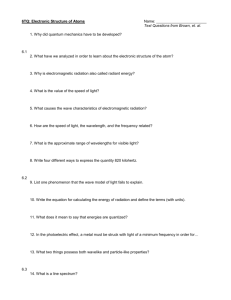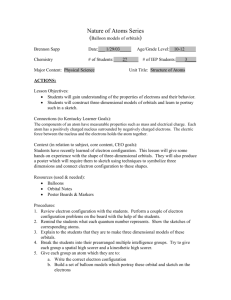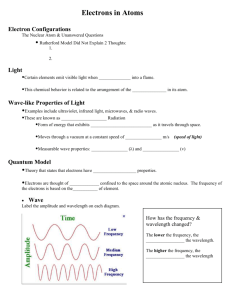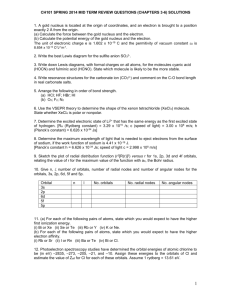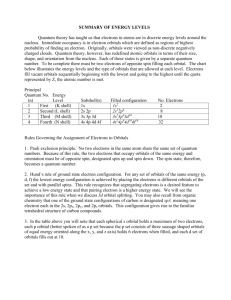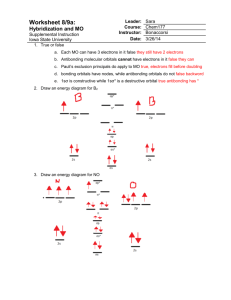Unit 6B: Bonding Theory and Atomic Structure
advertisement
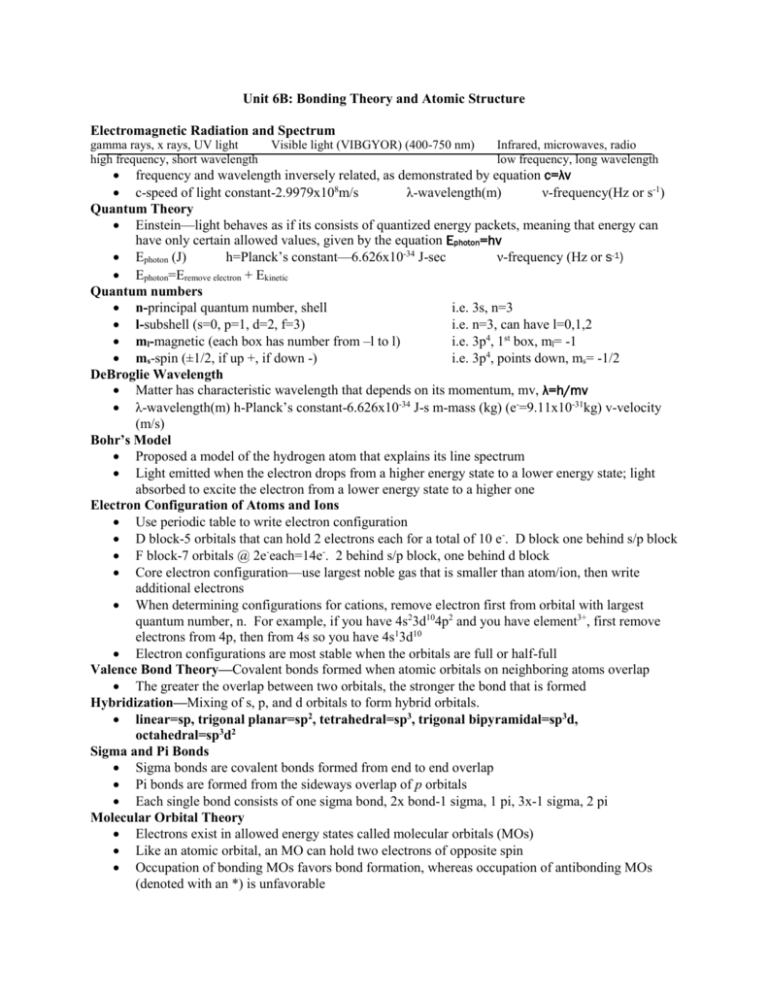
Unit 6B: Bonding Theory and Atomic Structure Electromagnetic Radiation and Spectrum gamma rays, x rays, UV light high frequency, short wavelength Visible light (VIBGYOR) (400-750 nm) Infrared, microwaves, radio low frequency, long wavelength frequency and wavelength inversely related, as demonstrated by equation c=λν c-speed of light constant-2.9979x108m/s λ-wavelength(m) ν-frequency(Hz or s-1) Quantum Theory Einstein—light behaves as if its consists of quantized energy packets, meaning that energy can have only certain allowed values, given by the equation Ephoton=hν Ephoton (J) h=Planck’s constant—6.626x10-34 J-sec ν-frequency (Hz or s-1) Ephoton=Eremove electron + Ekinetic Quantum numbers n-principal quantum number, shell i.e. 3s, n=3 l-subshell (s=0, p=1, d=2, f=3) i.e. n=3, can have l=0,1,2 ml-magnetic (each box has number from –l to l) i.e. 3p4, 1st box, ml= -1 ms-spin (±1/2, if up +, if down -) i.e. 3p4, points down, ms= -1/2 DeBroglie Wavelength Matter has characteristic wavelength that depends on its momentum, mv, λ=h/mv λ-wavelength(m) h-Planck’s constant-6.626x10-34 J-s m-mass (kg) (e-=9.11x10-31kg) v-velocity (m/s) Bohr’s Model Proposed a model of the hydrogen atom that explains its line spectrum Light emitted when the electron drops from a higher energy state to a lower energy state; light absorbed to excite the electron from a lower energy state to a higher one Electron Configuration of Atoms and Ions Use periodic table to write electron configuration D block-5 orbitals that can hold 2 electrons each for a total of 10 e-. D block one behind s/p block F block-7 orbitals @ 2e-each=14e-. 2 behind s/p block, one behind d block Core electron configuration—use largest noble gas that is smaller than atom/ion, then write additional electrons When determining configurations for cations, remove electron first from orbital with largest quantum number, n. For example, if you have 4s23d104p2 and you have element3+, first remove electrons from 4p, then from 4s so you have 4s13d10 Electron configurations are most stable when the orbitals are full or half-full Valence Bond Theory—Covalent bonds formed when atomic orbitals on neighboring atoms overlap The greater the overlap between two orbitals, the stronger the bond that is formed Hybridization—Mixing of s, p, and d orbitals to form hybrid orbitals. linear=sp, trigonal planar=sp2, tetrahedral=sp3, trigonal bipyramidal=sp3d, octahedral=sp3d2 Sigma and Pi Bonds Sigma bonds are covalent bonds formed from end to end overlap Pi bonds are formed from the sideways overlap of p orbitals Each single bond consists of one sigma bond, 2x bond-1 sigma, 1 pi, 3x-1 sigma, 2 pi Molecular Orbital Theory Electrons exist in allowed energy states called molecular orbitals (MOs) Like an atomic orbital, an MO can hold two electrons of opposite spin Occupation of bonding MOs favors bond formation, whereas occupation of antibonding MOs (denoted with an *) is unfavorable





